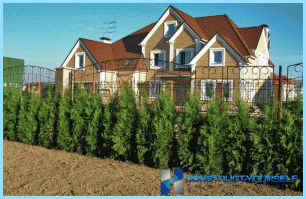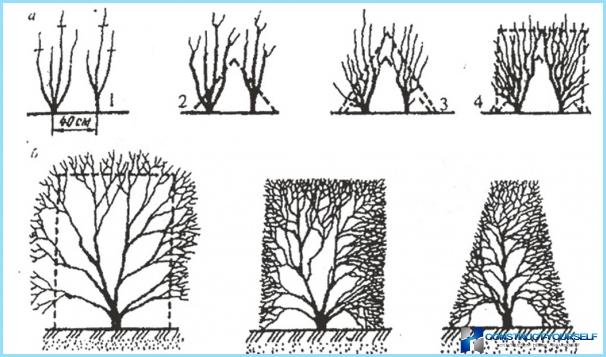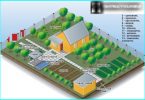The contents
Hedge – fashionable element of the design of a country house and its surrounding areas. Boring profile, metal, wood and stone fences can be decorated with a green wall of shrubs. As a decorative fence you can use different types of plants. However, the preference is still better to give the bulk of evergreen crops, for example, Thue.
Thuja is undemanding evergreen. The main feature of it is that in the process of growth it can give any form. This fact determines its suitability for planting in a hedge. In addition to practical properties of thuja has medicinal properties as other conifers. Volatile substances secreted her into the atmosphere, have antimicrobial properties. So choosing th as the fence stands, you will receive not only a functional fence, but a pure and wholesome air on the site.
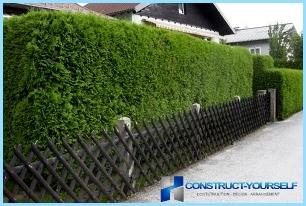
Where to use? ↑
Arborvitae is a shrub, reaching a height of 20-25 meters, which allows it to be used in almost any landscape design. Depending on the species of thuja are used as decor of the Alpine hills, rockeries, artificial and natural ponds, fountains, flower beds and alleys. In any case, a strict view of the plant and its versatility will carry an aesthetic touch.
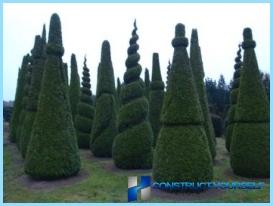
Where planted? ↑
The shrub is undemanding, so it can be planted on soils of any composition. Optimum planting in partial shade, this option is considered ideal. In the sun the plant turns yellow and dries up, however, if it is to provide proper care, this problem can be solved.
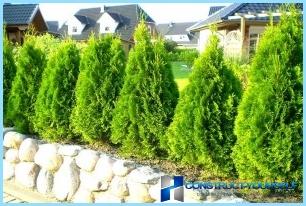
Species and cultivars ↑
Thuja is a plant whose homeland is the warm, southern regions. In our climate the preferred varieties such as «Brabant», «Smaragd», «Holmstrup». These varieties are adapted to the harsh conditions, can easily tolerate low temperatures and extreme heat.
«Brabant» – a variety of thuja, which is characterized by rapid growth and resistance to frost. Trees reach up to 15 meters in height. That the above properties makes this grade most suitable for creating hedges.
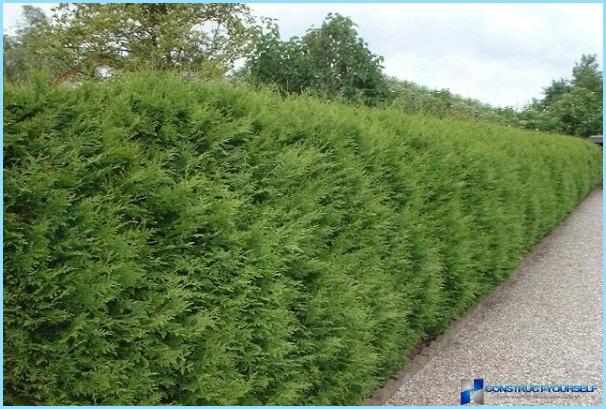
«Smaragd» – this variety has a special conical shape, is perfect for a single ornamental planting and hedges.
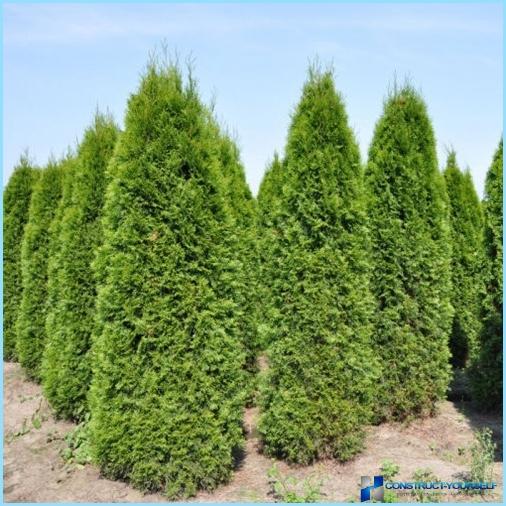
«Holmstrup» – low-growing varieties of arborvitae is characterized by slow growth. Used as hedges, but it does not require shearing. The maximum height of plants of this species reaches 2-2,5 meters.
Varieties «Smaragd» and «Brabant» – the most viable option hedges of arborvitae. Both varieties lend themselves perfectly shaped and perfectly grow. From this «living clay» you can create any song, from classical fence to the weird shapes. However, it is better to use Emerald as the crown of this subspecies grows outwards, allowing you to create a fence with no holes – dense thickets provide a uniform wall.
How to plant? ↑
Thuja propagated by cuttings. However, the proliferation of shrubs is carried out in specialized nurseries. The stores sell ready seedlings-children of the same age, ready for planting.
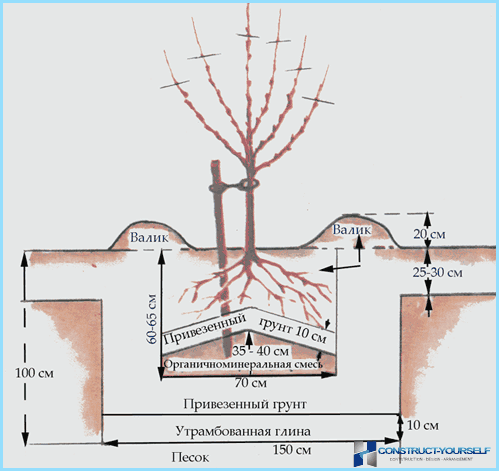
A hedge of arborvitae is laid in spring or autumn. In order to properly land the hedges should follow simple rules:
- the distance between plants 1.5-2 meters. If you plan to make a fence in tiers, then produce a layout, where maintaining the proportions: the distance between plants was 0.5 m, and between rows 1 meter;
- the depth of the pit is 80 cm, the size is selected individually depending on the rootstock;
- be sure when planting directly into the hole making a mixture of peat, sand, fertilizer, regardless of soil type;
- bury the seedling so that the root neck was underground.
What do we need? ↑
Materials and tools required for planting a green wall of arborvitae:
- seedlings usually are Packed in nurseries in pots;
- garden tools (shovel, rake, drill, watering can for watering or irrigation system);
- turf soil;
- compost;
- the peat mixture, it can be purchased at any gardening store;
- sand;
- drainage;
- water for irrigation;
- the combined mineral fertilizer;
- Kraft paper;
- scissors or shears for trimming hedges.
How to care? ↑
A hedge of arborvitae requires care, despite the fact that seedlings are unpretentious. In the first year the rows of shrubs should be regularly weeded. Watering of a hedge is required, especially if the rows are planted in an open area.
The first two years the plants require fertilizer. As power supply you can use a special blend that is sold in stores for gardeners. Such activities are recommended 2-3 times per year. As a result, young trees will get stronger.
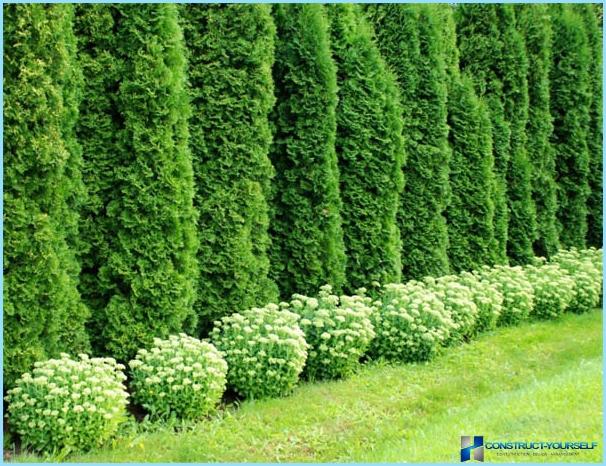
Since arborvitae do not tolerate the scorching sun, especially the young shrubs covered with awning on hot days and watering is carried out by sprinkling method. In the winter, to avoid freezing the roots the roots insulated and tied the branches to the trunk to snowfall and strong winds didn’t damage it.
Another important point in the care of the thuja is a haircut. It is performed in spring and autumn. The process involves not only the removal of damaged and dead shoots, but the formation of the crown.
To get acquainted with the intricacies of pruning we can see in the video.
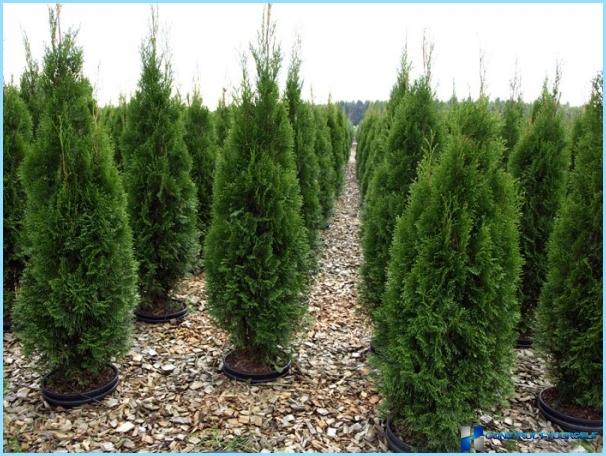
A hedge of arborvitae varieties Smaragd Brabant and is the ideal fencing for your country house. Such a fence will protect from dust and dirt, prying eyes and will create a harmonious design that will fit into the overall image of any area, regardless of the style.
With proper and regular maintenance of such fence will delight more than one year.

